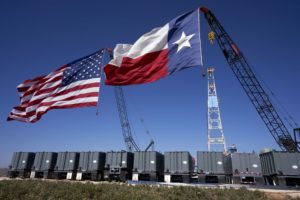 People are flocking to the Lone Star State, lured by ample land, big, diverse cities and a growing economy. To keep thriving, a new pragmatism is needed.
People are flocking to the Lone Star State, lured by ample land, big, diverse cities and a growing economy. To keep thriving, a new pragmatism is needed.
More Americans are realizing that Texas is the future. With its vast land area, thriving cities, ample resources and cosmopolitan diversity, the Lone Star State is attracting inflows of population from all over the country, and the news media seems to recognize the state’s importance. But if it’s going to fulfill its promise, Texas will have to make some changes.
Its status as the state that embodies America’s future is most clearly seen when compared to California. For decades, the Golden State outgrew the Lone Star State, but in recent years the gap has begun to narrow:
Moving to Texas
As more people move to the Lone Star State, its population is catching up to California.
Dysfunctional California politics have made housing unaffordable, causing people to flee to Texas’ sprawling, comparatively cheap suburbia and low tax rates. But if Texas is going to provide housing, jobs, and a high quality of life to those new arrivals — and thus ensure the boom continues — it’s going to have to improve its energy infrastructure, technology policy, universities and urbanism.
The state’s most obvious shortcomings were demonstrated in the recent winter storm, which left millions of Texans without heat or electricity during a rare streak of below-freezing temperatures that killed at least 58. After seeing power plants of every type fail, Texans were treated to the shameful spectacle of their governor and one of their senators attempting to blame the power outage on wind power and progressive energy policy. In fact, it was Texas’ failure to winterize power plants and natural gas infrastructure, as well as its insistence on being cut off from the rest of the country’s power grid, that left its citizens with their teeth chattering in lightless houses.
Trying to turn energy into a culture war won’t do anything to help the average Texan — it’ll simply limit the state’s ability to take advantage of the renewable energy technologies that are becoming cheaper by the day. Instead, Texas should embrace the pragmatism of the late businessman T. Boone Pickens, who switched from an oil baron to a champion of wind power when the cost started to make sense.
Diversifying Texas’ energy mix will also help expand its economy. Though Texas is much less oil-dependent than in the 1970s, Houston is still primarily a petroleum industry cluster, and therefore vulnerable to the end of the fossil-fuel age. Fortunately, after a long drought of investment, technology companies are taking a renewed interest in Texas, led by Elon Musk’s companies SpaceX and Tesla Inc. and by some old-line companies like Hewlett Packard Enterprise Co. and Oracle Corp. But Texas still has a huge uphill battle to fight in order to lure software jobs away from the West Coast:
The Draw of the West
California and Washington state have been getting the lion’s share of jobs in software publishing
Texas can make a start on turning this around by banning noncompete agreements. Noncompete contracts seem like a pro-business policy because each individual company would love to keep its workers away from competitors. But that ends up hurting the whole tech industry ecosystem, because talent and ideas are prevented from flowing between companies.
Texas also needs to upgrade its university system. Currently, the state has two big flagship public schools — the University of Texas at Austin and Texas A&M University — as well as some decently ranked private schools like Rice University and Southern Methodist University. But its schools lag well behind California’s in the rankings, and there just aren’t enough of them. (I say this even though my father is a professor at A&M.)
Universities are key for regional economic development. The biggest way they boost college towns is by conducting research that pulls skilled workers in from elsewhere, which in turn draws in corporate investment. Meanwhile, even if undergraduates move away after graduation, many will stay in the same state, adding to the pool of human capital that attracts businesses to an area. Upgrading both its flagship schools and its second-tier schools might cost a lot of money, but it would allow Texas to attract more of the technology industry investment it needs.
Given all that, when people move to Texas, they’ll need a place to live. The great tragedy of California is that its cities and towns limited housing supply until rents went through the roof and people were forced out. Now Texas is showing some ominous signs of making the same mistake. A 2018 report by the Manhattan Institute, a think tank, found that land use restrictions are driving up housing costs in Texas’ big cities. Austin is now one of the country’s pricier metropolises, while the cost of living in Houston and Dallas has been rising to a worrying degree, as well.
To avoid a California-like housing dystopia, Texas needs to liberalize land use regulations to allow greater density. This would fit with the state’s reputation as a small-government, pro-development place. But it also needs to build some public transit to accommodate the higher density, which would require taxes that might make some Texans balk.
In fact, all of these changes will be difficult and will upset some category of people — taxpayers, the oil industry, NIMBY homeowners and so on. In the past, Texas has often been the kind of place that put growth first. If it’s going to snatch California’s mantle to become the most important state in the union, it’s going to have to step on some toes.

